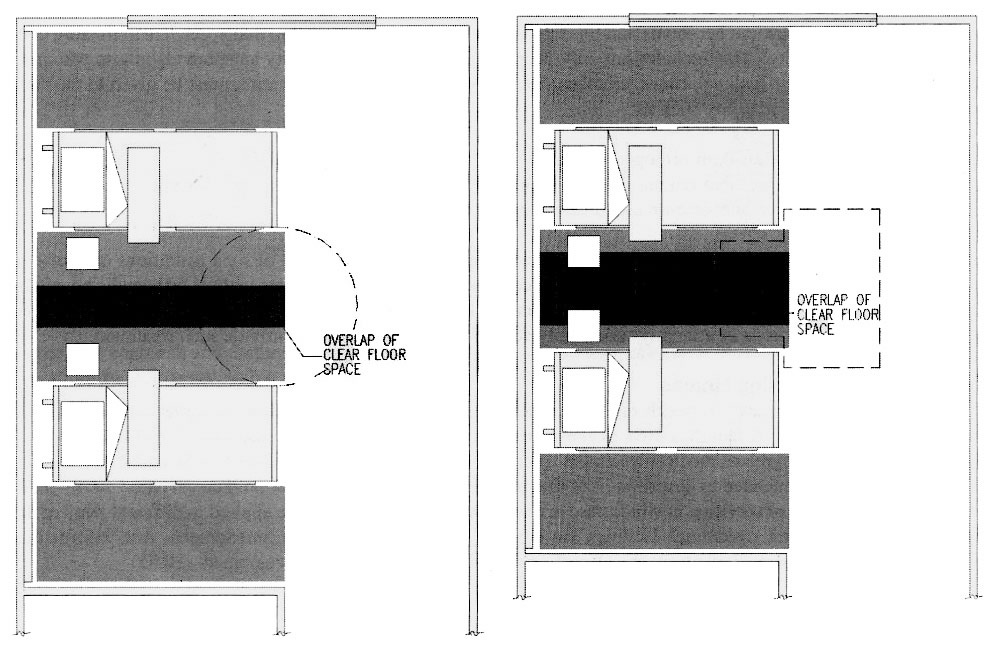Medical Care Facilities [6]
Section 6 covers access to patient bedrooms and applies to "medical care facilities" which are defined in part as those providing overnight stay. Those that do not, such as doctors' offices and outpatient facilities, are subject to other requirements of ADAAG. The facilities listed in section 6.1 are provided as examples of the three scoping categories. Other facilities not listed should be treated according to the examples they most closely resemble. The types of services provided and the characteristics of the intended population are often key in determining which scoping category to follow.
General
Because many patients in a medical care facility may experience reduced mobility during their stay, at least 10% of patient bedrooms and in-room bathrooms must be fully accessible. This category covers those facilities where the need for access is not likely to exceed the norm among medical occupancies. Examples include general purpose and pediatric hospitals, obstetric units, substance abuse treatment centers, and most mental health care facilities. All public use and common use areas are required to be fully accessible.
Hospitals and Rehabilitation Facilities Specializing in the Treatment of Conditions Affecting Mobility
Access is required to all patient bedrooms and toilet rooms in facilities or units within that specialize in treating conditions that affect mobility. This includes not only people who use wheeled mobility aids, but also those who may walk with difficulty or use walkers, canes, crutches, braces, or prostheses. Consideration must be given to the various conditions that affect mobility such as:
-
arthritic, neurological, or orthopedic conditions
-
respiratory diseases that require use of portable oxygen
-
cardiac conditions that impose significant functional limitations
It may be necessary to weigh the degree to which a facility specializes in treatment of such conditions over others, but careful consideration of the need among the intended population is key. Examples include orthopedic hospitals, physical rehabilitation facilities, and spinal cord or traumatic brain injury treatment centers. Scoping can be applied on a pro rata basis to portions of a facility where only certain units or departments provide such treatment.
Long Term Care / Nursing Homes
Definitions of "long term care" in health regulations, building codes, and accreditation standards can be used as a guide to determine in which facilities 50% of the patient room are required to be accessible. (ADAAG does not define the term). The degree of medical treatment or care provided at a facility may need to be taken into account since this section is not intended to cover facilities that provide residential but little or no medical care. Many facilities offer a combination of services, in which case accessibility requirements may be applied to different parts of the complex. New multi-unit residential facilities are covered by the Fair Housing Amendments Act; information regarding requirements is available from the Department of Housing and Urban Development (HUD).
Dispersion
Accessible bedrooms should be dispersed among all units or departments providing overnight stay and among different classes of rooms (private, semi-private, etc.). Industry practice and needs assessment can be used to further determine the distribution. For example, a greater number might be located in general surgical units than in pediatric and obstetric wards. Different units may be subject to different scoping requirements, such as an orthopedic wing (where 100% of patient rooms are required to be accessible) within a general hospital (where only 10% of patient bedrooms must be accessible).
Alterations / Additions
The minimum number of accessible patient rooms required is based on the total number of bedrooms that are altered or added, including where a unit or department is completely renovated. In partial renovations of a unit or department, altered bedrooms must be made accessible according to the number required in new construction unless that number is already met (either within that unit or in other parts of the facility).
Doors
The exception from latch-side maneuvering clearances is allowed only at acute care bedrooms, not throughout a hospital. Recommendation: Compliance with 4.13.6 is recommended because while wider door openings may facilitate access, they do not fully compensate for latch-side clearance, particularly on the pull side.
Bedside Clearances
Clearance at least 36 inches wide is required on each side of beds. Where more than one bed is provided, this space can overlap. Privacy curtains or screens that can be easily moved out of the way can also overlap this clearance. T-shaped space can be provided within bedside clearances. Turning space (60 inch diameter circle) is recommended between beds to allow additional maneuvering and transfer space.

Controls and Equipment
Access requirements apply to fixed controls and operating mechanisms intended for independent use by patients. Equipment and controls used by staff are not required to comply although access (or adaptability) may be advisable in some cases so that employees with disabilities can be more easily accommodated.
Patient Toilet Rooms [6.4]
ADAAG specifications are based on the independent use of toilet and bathing facilities and do not address alternate designs for assisted use. Requirements for both independent and assisted access can usually be met in facilities where ADAAG applies to a portion (10% or 50%) of patient bedrooms. Where all patient bedrooms (and toilet rooms) must comply, alternatives to certain ADAAG specifications may be possible as an equivalent facilitation, as permitted in 2.2. Any considered departures should be based on a careful assessment of:
-
the needs of the intended population
-
the degree to which an ADAAG specification and a preferred design conflict
-
the feasibility of designs that can accommodate both independent and assisted access

User Comments/Questions
Add Comment/Question